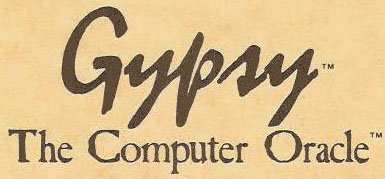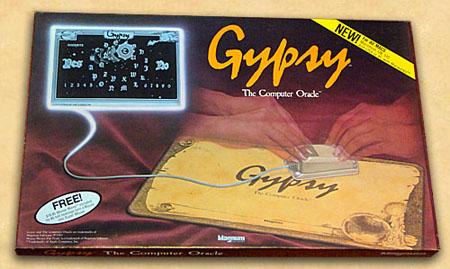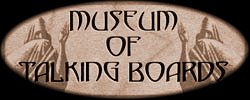
 The
first computerized Ouija board was Scott McTyre's
(Magnum Software) Gypsy - The Computer
Oracle for the Macintosh in 1985.
Gypsy came with all the necessary
software and instructions. There was a board with an appropriately arcane
design and a "Mouse
Mover" to convert the mouse into a turbo-charged
planchette. A brief introduction set the mood for the
session:
The
first computerized Ouija board was Scott McTyre's
(Magnum Software) Gypsy - The Computer
Oracle for the Macintosh in 1985.
Gypsy came with all the necessary
software and instructions. There was a board with an appropriately arcane
design and a "Mouse
Mover" to convert the mouse into a turbo-charged
planchette. A brief introduction set the mood for the
session:
"Since the beginning of time the human race has looked beyond itself . . . hoping to find some mysterious force it could contact to get answers. Answers about the future. About love and romance. About friends and enemies . . . power and wealth . . . life and death. Answers about anything and everything. This desire for knowing the unknown produced a belief in mystics, seers, sorcerers, wizards, witches, soothsayers, fortune tellers and oracles. For example: Thousands of years ago Rome, Persia, India, Greece and China believed in the amazing power of their oracles. The oracles took many forms. That which has survived through 30 centuries - the mystic table - had a surface displaying signs or letters and numerals. A free moving object was used as the selector. When the supplicant assumed the correct frame of mind and touched the selector it moved of its own volition, and delivered its messages by pausing at the signs or letters. Then, as now, some messages were crystal clear, others needed interpretation. Homemade and commercial forms of this arcane table were the rage during the early and mid 1900's and its extraordinary popularity has survived even up to today. It's estimated that several million are currently in use. Gypsy, by Magnum, is the modern day, computerized version of the ancient mystic game."
The MacDruxman Report said, " Whether you're a true believer in the world beyond, or are simply looking for a good party game, Gypsy makes Ouija state-of-the art." With a send up like that, Gypsy just had to be a success. The "Mouse Mover" also got a lot of attention. It was a ball-bearing platform that ingeniously snapped to the mouse bottom and made it glide so effortlessly that you would swear you never touched it. It seemed almost supernatural and was so innovative that it won the best accessory award for 1986 from MacUser Magazine.
The board lacked letters or numbers and acted as an oversized mouse pad. You created the talking board on your Mac using the supplied software and MacPaint. In a jiffy you could make any number of layouts with different formats. A few basic designs came included for inspiration. A user could change fonts and backgrounds and use any picture to make the board unique. There was a "star bucket" to add blinking stars and constellations to the design. Planchettes were just as configurable
As you moved the cursor to the letters, now fortified with the Mouse Mover, messages appeared on screen. Unfortunately, spirits speaking through Gypsy might spell just as poorly as those speaking through a conventional Ouija board so there could be some interpreting. A text editor helped decipher the more difficult sentences. Failing that, you could switch to "Automatic Writing Mode" and a blank board. The planchette then became an automatic writer. Messages presumably appeared in script as you, or the spirits, moved the mouse. Gypsy - The Computer Oracle sold for $39.95 and worked on the Macintosh 128, 512, and Lisa or XL with Macworks.

Copyright © All Rights Reserved.